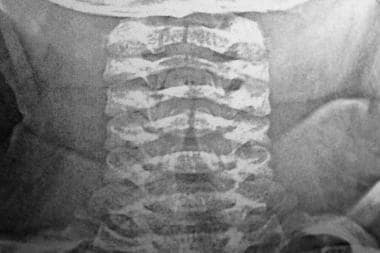Practice Essentials
Except in patients with a tracheostomy or an endotracheal tube, bacterial tracheitis is an uncommon infectious cause of acute upper airway obstruction. It is more prevalent than acute epiglottitis among children who have received Haemophilus influenzae type b (Hib) vaccine.
Patients may present with crouplike symptoms, such as barking cough, stridor, and fever; however, patients with bacterial tracheitis do not respond to standard croup therapy (racemic epinephrine) and instead require treatment with antibiotics and may experience acute respiratory decompensation. [1, 2, 3, 4] Radiographs may reveal subglottic narrowing on anteroposterior views (Steeple sign). See the image below.
Signs and symptoms
In the classic presentation, patients present acutely with fevers, toxic appearance, stridor, tachypnea, and respiratory distress. Cough is frequent and not painful.
See Presentation for more detail.
Diagnosis
Laboratory studies
Obtain bacterial culture and Gram staining of tracheal secretions and blood cultures in patients with suspected bacterial tracheitis.
Imaging studies
Radiography of the neck may be indicated.
See Workup for more detail.
Management
Maintenance of an adequate airway is of primary importance. Once the airway is stabilized, obtain intravenous access for initiation of antibiotics.
Tracheostomy is rarely necessary unless injury or trauma to the airway has caused scarring and documented narrowing of the airway.
See Treatment and Medication for more detail.
Patient education
Advise patients and their family to keep immunizations up-to-date.
Pathophysiology
Bacterial tracheitis is a diffuse inflammatory process of the larynx, trachea, and bronchi with adherent or semiadherent mucopurulent membranes within the trachea. The major site of disease is at the cricoid cartilage level, the narrowest part of the trachea. Acute airway obstruction may develop secondary to subglottic edema and sloughing of epithelial lining or accumulation of mucopurulent membrane within the trachea. Signs and symptoms are usually intermediate between those of epiglottitis and croup. [5, 6]
Bacterial tracheitis may be more common in the pediatric patient because of the size and shape of the subglottic airway. The subglottis is the narrowest portion of the pediatric airway, assuming a funnel-shaped internal dimension. In this smaller airway, relatively little edema can significantly reduce the diameter of the pediatric airway, increasing resistance to airflow and work of breathing. With appropriate airway support and antibiotics, most patients improve within 5 days.
Although the pathogenesis of bacterial tracheitis is unclear, mucosal damage or impairment of local immune mechanisms due to a preceding viral infection, an injury to the trachea from recent intubation, or trauma may predispose the airway to invasive infection with common pyogenic organisms.
Etiology
The following causes have been noted:
-
S aureus: Community-associated methicillin-resistant S aureus (CA-MRSA) has emerged as an important agent in the United States; this could result in a greater frequency of MRSA strains that cause tracheitis.
-
S pyogenes, Streptococcus pneumoniae, and other alpha hemolytic streptococcal species
-
Moraxella catarrhalis: Reports suggest it is a leading cause of bacterial tracheitis and associated with increased intubation.
-
Haemophilus influenzae type b (Hib): This cause is less common since the introduction of the Hib vaccine.
-
Klebsiella species
-
Pseudomonas species
-
Anaerobes
-
Peptostreptococcus species
-
Bacteroides species
-
Prevotella species
-
Other
Mycoplasma pneumoniae
Mycobacterium tuberculosis (endobronchial disease)
H1N1 influenza [7]
In two case series in the United States, the most common bacteria identified was methicillin-sensitive Staphylococcus aureus. [8, 9]
Epidemiology
United States statistics
Tan and Manoukian reported that 500 children were hospitalized for croup at one pediatric hospital over a 32-month period. [10] Approximately 98% had viral croup, and 2% had bacterial tracheitis. Cases usually occur in the fall or winter months, mimicking the epidemiology of viral croup.
A study that described the frequency and severity of complications in hospitalized children younger than 18 years with seasonal influenza (during 2003-2009) and 2009 pandemic influenza A(H1N1) (during 2009-2010) reported that out of 7293 children hospitalized with influenza, less than 2% had complications from tracheitis. However, along with other rare complications, tracheitis was associated with a median hospitalization duration of more than 6 days, with 48%-70% of children requiring intensive care. [11]
International statistics
Bacterial tracheitis remains a rare condition, with an estimated incidence of approximately 0.1 cases per 100,000 children per year. [12]
Sex- and age-related demographics
In most epidemiologic studies, male cases are preponderant. Gallagher et al reported a male-to-female predominance of 2:1. [13]
Bacterial tracheitis may occur in any pediatric age group. Gallagher et al reported 161 cases of patients younger than 16 years. [13] The age range was from 3 weeks to 16 years, with a mean age of 4 years. This is in contrast to viral laryngotracheobronchitis, which occurs in patients aged 6 months to 3 years.
Prognosis
Once the patient is past the acute phase, complete recovery is expected.
Morbidity/mortality
The predominant morbidity and mortality is related to the potential for acute upper airway obstruction and induced hypoxic insults. The mortality rate has been estimated at 4-20%. In the acute phase, patients generally do well if the airway is adequately managed and if antibiotic therapy is promptly initiated.
Complications
The following complications have been reported:
-
Septicemia
-
Toxic shock
-
Adult respiratory distress syndrome (ARDS)
-
Endotracheal tube complications
Plugging, accidental extubation
Postextubation stridor, subglottic stenosis
-
Anoxic encephalopathy
-
Cardiorespiratory arrest
A retrospective study by Gross et al, in which four patients who received antibiotic treatment for bacterial laryngotracheitis showed improvement in presumed iatrogenic laryngotracheal stenosis, suggested that airway bacterial growth is significantly involved in adult postintubation airway injury. The patients had a history of intubation and/or tracheostomy, with complete resolution of upper airway obstruction seen in three of the patients after laryngotracheitis treatment and significant improvement of airway status seen in the fourth. [15]
-
Steeple sign.








